Ricardo J. Bessa
A Conceptual Framework for AI-based Decision Systems in Critical Infrastructures
Apr 21, 2025



Abstract:The interaction between humans and AI in safety-critical systems presents a unique set of challenges that remain partially addressed by existing frameworks. These challenges stem from the complex interplay of requirements for transparency, trust, and explainability, coupled with the necessity for robust and safe decision-making. A framework that holistically integrates human and AI capabilities while addressing these concerns is notably required, bridging the critical gaps in designing, deploying, and maintaining safe and effective systems. This paper proposes a holistic conceptual framework for critical infrastructures by adopting an interdisciplinary approach. It integrates traditionally distinct fields such as mathematics, decision theory, computer science, philosophy, psychology, and cognitive engineering and draws on specialized engineering domains, particularly energy, mobility, and aeronautics. The flexibility in its adoption is also demonstrated through its instantiation on an already existing framework.
On the Definition of Robustness and Resilience of AI Agents for Real-time Congestion Management
Apr 17, 2025Abstract:The European Union's Artificial Intelligence (AI) Act defines robustness, resilience, and security requirements for high-risk sectors but lacks detailed methodologies for assessment. This paper introduces a novel framework for quantitatively evaluating the robustness and resilience of reinforcement learning agents in congestion management. Using the AI-friendly digital environment Grid2Op, perturbation agents simulate natural and adversarial disruptions by perturbing the input of AI systems without altering the actual state of the environment, enabling the assessment of AI performance under various scenarios. Robustness is measured through stability and reward impact metrics, while resilience quantifies recovery from performance degradation. The results demonstrate the framework's effectiveness in identifying vulnerabilities and improving AI robustness and resilience for critical applications.
Budget-constrained Collaborative Renewable Energy Forecasting Market
Jan 21, 2025Abstract:Accurate power forecasting from renewable energy sources (RES) is crucial for integrating additional RES capacity into the power system and realizing sustainability goals. This work emphasizes the importance of integrating decentralized spatio-temporal data into forecasting models. However, decentralized data ownership presents a critical obstacle to the success of such spatio-temporal models, and incentive mechanisms to foster data-sharing need to be considered. The main contributions are a) a comparative analysis of the forecasting models, advocating for efficient and interpretable spline LASSO regression models, and b) a bidding mechanism within the data/analytics market to ensure fair compensation for data providers and enable both buyers and sellers to express their data price requirements. Furthermore, an incentive mechanism for time series forecasting is proposed, effectively incorporating price constraints and preventing redundant feature allocation. Results show significant accuracy improvements and potential monetary gains for data sellers. For wind power data, an average root mean squared error improvement of over 10% was achieved by comparing forecasts generated by the proposal with locally generated ones.
A Perspective on Foundation Models for the Electric Power Grid
Jul 12, 2024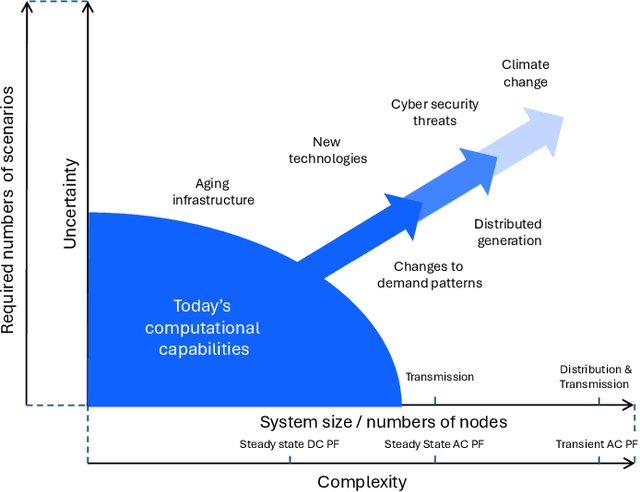
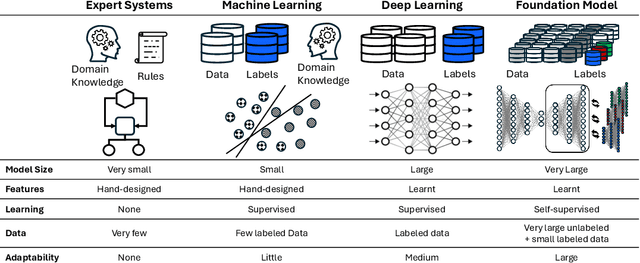
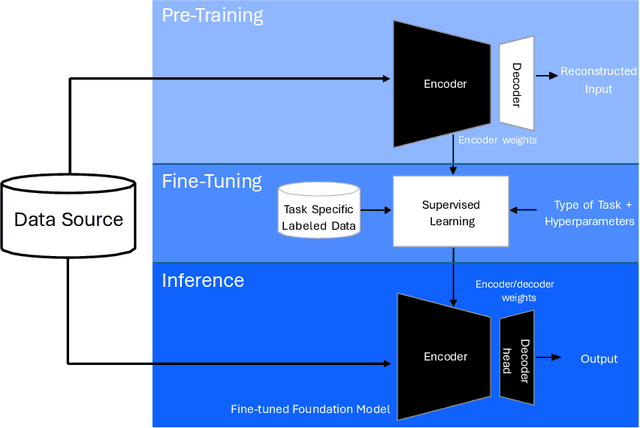

Abstract:Foundation models (FMs) currently dominate news headlines. They employ advanced deep learning architectures to extract structural information autonomously from vast datasets through self-supervision. The resulting rich representations of complex systems and dynamics can be applied to many downstream applications. Therefore, FMs can find uses in electric power grids, challenged by the energy transition and climate change. In this paper, we call for the development of, and state why we believe in, the potential of FMs for electric grids. We highlight their strengths and weaknesses amidst the challenges of a changing grid. We argue that an FM learning from diverse grid data and topologies could unlock transformative capabilities, pioneering a new approach in leveraging AI to redefine how we manage complexity and uncertainty in the electric grid. Finally, we discuss a power grid FM concept, namely GridFM, based on graph neural networks and show how different downstream tasks benefit.
A Pioneering Roadmap for ML-Driven Algorithmic Advancements in Electrical Networks
May 28, 2024



Abstract:To advance control, operation and planning tools of electrical networks with ML is not straightforward. 110 experts were surveyed showing where and how ML algorithmis could advance. This paper assesses this survey and research environment. Then it develops an innovation roadmap that helps align our research community towards a goal-oriented realisation of the opportunities that AI upholds. This paper finds that the R\&D environment of system operators (and the surrounding research ecosystem) needs adaptation to enable faster developments with AI while maintaining high testing quality and safety. This roadmap may interest research centre managers in system operators, academics, and labs dedicated to advancing the next generation of tooling for electrical networks.
Functional Model of Residential Consumption Elasticity under Dynamic Tariffs
Nov 22, 2021



Abstract:One of the major barriers for the retailers is to understand the consumption elasticity they can expect from their contracted demand response (DR) clients. The current trend of DR products provided by retailers are not consumer-specific, which poses additional barriers for the active engagement of consumers in these programs. The elasticity of consumers demand behavior varies from individual to individual. The utility will benefit from knowing more accurately how changes in its prices will modify the consumption pattern of its clients. This work proposes a functional model for the consumption elasticity of the DR contracted consumers. The model aims to determine the load adjustment the DR consumers can provide to the retailers or utilities for different price levels. The proposed model uses a Bayesian probabilistic approach to identify the actual load adjustment an individual contracted client can provide for different price levels it can experience. The developed framework provides the retailers or utilities with a tool to obtain crucial information on how an individual consumer will respond to different price levels. This approach is able to quantify the likelihood with which the consumer reacts to a DR signal and identify the actual load adjustment an individual contracted DR client provides for different price levels they can experience. This information can be used to maximize the control and reliability of the services the retailer or utility can offer to the System Operators.
Simulating Tariff Impact in Electrical Energy Consumption Profiles with Conditional Variational Autoencoders
Jun 10, 2020


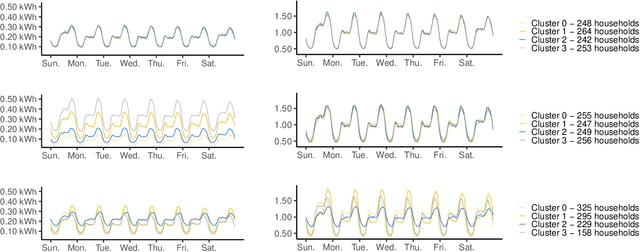
Abstract:The implementation of efficient demand response (DR) programs for household electricity consumption would benefit from data-driven methods capable of simulating the impact of different tariffs schemes. This paper proposes a novel method based on conditional variational autoencoders (CVAE) to generate, from an electricity tariff profile combined with exogenous weather and calendar variables, daily consumption profiles of consumers segmented in different clusters. First, a large set of consumers is gathered into clusters according to their consumption behavior and price-responsiveness. The clustering method is based on a causality model that measures the effect of a specific tariff on the consumption level. Then, daily electrical energy consumption profiles are generated for each cluster with CVAE. This non-parametric approach is compared to a semi-parametric data generator based on generalized additive models and that uses prior knowledge of energy consumption. Experiments in a publicly available data set show that, the proposed method presents comparable performance to the semi-parametric one when it comes to generating the average value of the original data. The main contribution from this new method is the capacity to reproduce rebound and side effects in the generated consumption profiles. Indeed, the application of a special electricity tariff over a time window may also affect consumption outside this time window. Another contribution is that the clustering approach segments consumers according to their daily consumption profile and elasticity to tariff changes. These two results combined are very relevant for an ex-ante testing of future DR policies by system operators, retailers and energy regulators.
A Critical Overview of Privacy-Preserving Approaches for Collaborative Forecasting
May 22, 2020
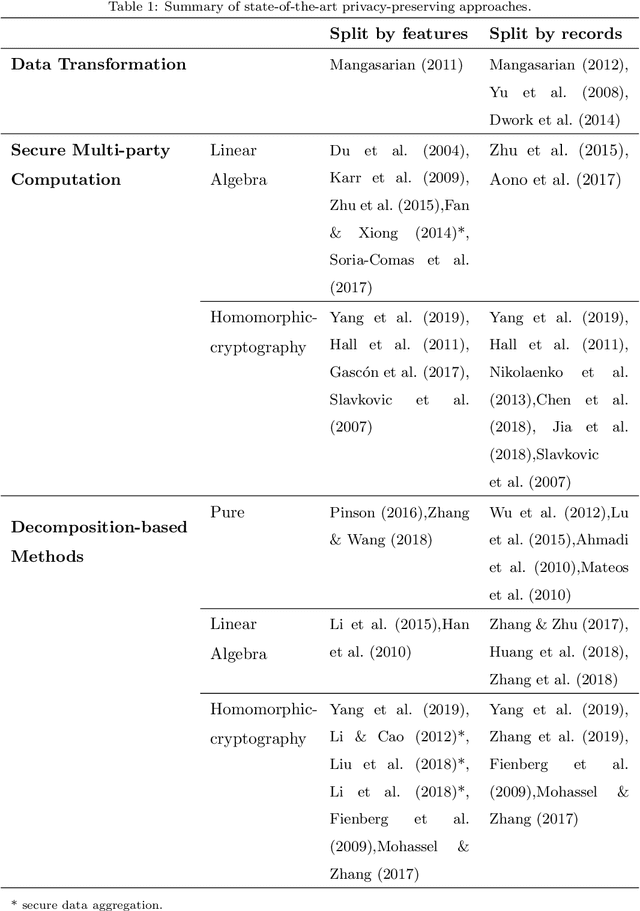


Abstract:Cooperation between different data owners may lead to an improvement in forecast quality - for instance by benefiting from spatial-temporal dependencies in geographically distributed time series. Due to business competitive factors and personal data protection questions, said data owners might be unwilling to share their data, which increases the interest in collaborative privacy-preserving forecasting. This paper analyses the state-of-the-art and unveils several shortcomings of existing methods in guaranteeing data privacy when employing Vector Autoregressive (VAR) models. The paper also provides mathematical proofs and numerical analysis to evaluate existing privacy-preserving methods, dividing them into three groups: data transformation, secure multi-party computations, and decomposition methods. The analysis shows that state-of-the-art techniques have limitations in preserving data privacy, such as a trade-off between privacy and forecasting accuracy, while the original data in iterative model fitting processes, in which intermediate results are shared, can be inferred after some iterations.
 Add to Chrome
Add to Chrome Add to Firefox
Add to Firefox Add to Edge
Add to Edge